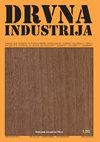热电堆的热修正强度。Dio 1
IF 0.8
4区 农林科学
Q4 MATERIALS SCIENCE, PAPER & WOOD
引用次数: 0
摘要
木材热处理是一种环保方法,热处理木材的性能与热改性强度密切相关。本研究以 160~220 ℃热处理的杨木 0-3 mm 表层(SL)为研究对象。评估了改性强度,包括表层的颜色、硬度、化学成分和形态变化。研究结果表明,热处理前后杨木的色差(ΔE*1)增大;SL 上表面和下表面的色差(ΔE*2)也随着处理温度的升高而增大。因此,表面硬度(HR)随着处理强度的增加而降低。当处理温度高于 160 ℃ 时,SL 的上表面和下表面在颜色上有统计学差异。化学成分分析表明,热处理会降解木材成分,尤其是半纤维素,相关分析表明半纤维素的变化率与 ΔE*1 或 HR 值之间存在显著的相关性;预测函数的置信度高达 0.99。总体而言,杨木热处理表层(SL)的热改性强度各不相同,HR 值和ΔE*1 值可用于表征和预测杨木热处理表层的改性强度和热降解程度。本文章由计算机程序翻译,如有差异,请以英文原文为准。
Intenzitet toplinske modifikacije topolovine. Dio 1
Wood heat treatment is an environmentally friendly method, and the heat-treated wood properties are closely related to thermal modification intensity. This study focuses on the 0-3 mm surface layer (SL) of poplar wood heat treated at 160~220 °C. The modification intensity, including surface color, hardness, chemical component and morphological changes of the SL, was evaluated. The findings of this research showed that the color difference of the poplar wood before and after heat treatment (ΔE*1) increased; the color difference between up-surface and down-surface of the SL (ΔE*2) also increased with the treatment temperature. Consequently, the surface hardness (HR) decreased with the increase of treatment intensity. When the treatment temperature was higher than 160 °C, the up-surface and down-surface of the SL were statistically different in color. Chemical component analysis revealed that the heat treatment degrades wood components, especially the hemicellulose, and correlation analysis showed a significant correlation between the change rate of hemicellulose and the ΔE*1 or HR value; the prediction functions have been established at a high confidence level of 0.99. Overall, the thermal modification intensity of the heat-treated surface layer (SL) of poplar wood varies, and the HR and ΔE*1 value could be used to characterize and predict the modification intensity and degree of thermal degradation of the surface layer of heat-treated poplar wood.
求助全文
通过发布文献求助,成功后即可免费获取论文全文。
去求助
来源期刊

Drvna Industrija
MATERIALS SCIENCE, PAPER & WOOD-
CiteScore
1.80
自引率
9.10%
发文量
32
审稿时长
>12 weeks
期刊介绍:
"Drvna industrija" ("Wood Industry") journal publishes original scientific and review papers, short notes, professional papers, conference papers, reports, professional information, bibliographical and survey articles and general notes relating to the forestry exploitation, biology, chemistry, physics and technology of wood, pulp and paper and wood components, including production, management and marketing aspects in the woodworking industry.
 求助内容:
求助内容: 应助结果提醒方式:
应助结果提醒方式:


